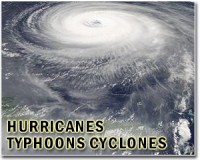 |
Barcelona, Spain (SPX) Jul 14, 2010 Researchers at Mathematics Research Centre and Universitat Autonoma de Barcelona have discovered the mathematical relation between the number of hurricanes produced in certain parts of the planet and the energy they release. The distribution is valid for all series of hurricanes under study, independent of when and where they occurred. The research, which will be published on Sunday online edition of Nature Physics, suggests that the evolution of hurricane intensity will be very difficult to predict. It is well known that there are less probabilities of a devastating hurricane developing than of a modest one. However, the exact relation between the number of hurricanes and energy released was not known until now. Researchers from the Mathematics Research Centre (CRM) and the Department of Physics of Universitat Autonoma de Barcelona have analyzed data corresponding to tropical cyclones (generic name used for hurricanes) which have appeared in different parts of the planet between 1945 and 2007. Scientists have discovered that this relation corresponds to a power-law, a precise mathematical formula cyclones obey in a surprising manner, regardless of where on the planet and when they appear. This fundamental discovery has led researchers to more general conclusions on the behavior of hurricanes. The first conclusion states that a hurricane's dynamics can be the result of a critical process, therefore making it impossible to predict its intensity. One of the aspects traditionally studied by organizations monitoring the danger of hurricanes is the prediction of their intensity, since this determines which alert and prevention systems are to be used in populated areas. Despite the efforts of scientists and resources invested, until now results have been very poor, although predictions on hurricane trajectory have improved considerably. The fact that hurricanes follow this power-law, as do other natural phenomena where large amounts of energy are released, e.g. earthquakes, questions the ability to predict the evolution of their intensity. In these types of processes, the dynamics behind large hurricanes are the same as those producing tropical storms of less importance and range. The way in which a small storm evolves and transforms into a catastrophic hurricane depends on whether the fluctuations amplifying the storm are stronger than those which tend to dissipate it. However, there is no specific aspect pointing to which will be the dominant fluctuations, since the system at that moment is in a critical situation, i.e. on the verge of either dissipating or growing. The second conclusion of the study is related to the effects of global warming on the behavior of tropical cyclones: a recent increase in activities in the North Atlantic has shown to follow the same pattern as other high-activity periods in the past. Although there has been a dramatic increase in the number of hurricanes occurring in the North Atlantic since mid-1990s when compared to the period starting in the 1970s, the distribution of hurricanes in the 1950s was similar to today's activity level. Therefore, this increase cannot be explained solely on the basis of climate change. Even so, the research points to the existence of a relation between global warming and the distribution of tropical cyclones. The number of hurricanes is inversely proportional to the energy released, except for the highest values of energy, where the relation is suddenly interrupted. Researchers have observed that the cut-off point where the power-law does not represent the behavior of hurricanes is influenced by factors such as average sea surface temperature and the El Nino phenomenon. Thus at a higher temperature, for example, the cut-off point rises to higher energy values.
Share This Article With Planet Earth
Related Links Universitat Autonoma de Barcelona Bringing Order To A World Of Disasters When the Earth Quakes A world of storm and tempest
 Tropical depression forms in Gulf of Mexico
Tropical depression forms in Gulf of MexicoMiami (AFP) July 8, 2010 A tropical depression in the Gulf of Mexico Thursday is threatening to grow into a storm that could further upend efforts to contain and clean up the massive BP oil spill. Tropical storm warnings were issued for the coast of the southern US state of Texas and northeastern Mexico. US meteorologists forecast the system will cut through the Gulf along a similar track as last week's Hurrican ... read more |
|
| The content herein, unless otherwise known to be public domain, are Copyright 1995-2010 - SpaceDaily. AFP and UPI Wire Stories are copyright Agence France-Presse and United Press International. ESA Portal Reports are copyright European Space Agency. All NASA sourced material is public domain. Additional copyrights may apply in whole or part to other bona fide parties. Advertising does not imply endorsement,agreement or approval of any opinions, statements or information provided by SpaceDaily on any Web page published or hosted by SpaceDaily. Privacy Statement |